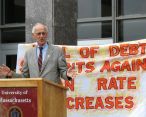Where We Stand on Student Loans

 There has been a lot of talk lately about the impending interest rate hike on federally subsidized Stafford loans. Here in Congress, I have been working hard to keep that from happening. Back in the First District, my constituents have also been active. My office has received calls, letters and Facebook posts on the subject. Last week, students at UMass and MWCC joined me in person to discuss the potential impact on First District students and families if interest rates are allowed to jump from 3.4% to 6.8% on July 1.
There has been a lot of talk lately about the impending interest rate hike on federally subsidized Stafford loans. Here in Congress, I have been working hard to keep that from happening. Back in the First District, my constituents have also been active. My office has received calls, letters and Facebook posts on the subject. Last week, students at UMass and MWCC joined me in person to discuss the potential impact on First District students and families if interest rates are allowed to jump from 3.4% to 6.8% on July 1.
Your voices have been heard and, although an agreement has not yet been reached, I am pleased that members of both parties have acknowledged that this problem needs to be addressed as soon as possible. Here is a brief update on where things stand at the moment and what the options are moving forward.
Background
On July 1, unless Congress acts to prevent it, the interest rate on federally-subsidized Stafford loans will double, jumping from 3.4 to 6.8%.
Subsidized Stafford Loans are only available to students who demonstrate financial need. These loans are subject to annual and cumulative limits, meaning there is a limit to how much one can borrow for a given academic year and also to the total amount that one can borrow. The interest rates for Stafford Loans are established by statute, which is why they can vary from year to year. The interest rate applied to a particular loan depends on when the loan was made.
Why It Matters
In the state of Massachusetts alone, there are over 160,000 student borrowers who would be affected in the coming year. These students will pay an additional $134 million in interest over the life of the loan—and that is just for one year’s tuition. Nationwide, roughly 7.4 million students are expected to be affected by the rate hike.
 According to the College Board, the average cost of tuition and fees at a public, four-year college has almost tripled since 1995, and has more than doubled for a private school education. Despite its rising cost, however, a college education is not a luxury. By 2018, 63 percent of all American job openings will require some sort of postsecondary education.
According to the College Board, the average cost of tuition and fees at a public, four-year college has almost tripled since 1995, and has more than doubled for a private school education. Despite its rising cost, however, a college education is not a luxury. By 2018, 63 percent of all American job openings will require some sort of postsecondary education.
Education is also the biggest determining factor for earning potential. Workers who hold bachelor's degrees earn about double the yearly earnings of workers with only a high school diploma, and those with Associates degrees earn about 50% more.
Making it more affordable for students to go to college doesn’t just help individual students; it makes for a more competitive national economy.
Possible Solutions
H.R.4628, the Interest Rate Reduction Act, was one approach. This bill would pay for an extension of the freeze by stripping funds from a critical component of the Health Care law, the Preventive Care fund. This bill passed the House on April 27 largely along party lines and over my strong objection. In addition to forcing students to choose between the health care they need and the education they need to pay for, this bill did not offer a real solution. With scant support in the Senate and a veto threat from the White House, it was clear from the beginning that this bill would not become law. H.R. 4628 is not the solution our students need. We can and must do better.
I am pleased to support what I believe to be a much better solution: H.R. 3826. This bill, sponsored by Rep. Joe Courtney, would amend the Higher Education Act of 1965 to extend the reduced interest rate for Federal Direct Stafford Loans without gutting key public programs.
I am also a co-sponsor of Rep. Tierney’s bill, H.R. 4816, the Stop the Rate Hike Act of 2012. This bill extends the 3.4% rate on Stafford loans by ending some of the tax subsidies given to major oil companies.
If those who oppose this bill are doing so because they cannot bring themselves to take back a single dollar from the billions we give to oil companies in tax breaks every year, despite the industry’s record profits, there are other offsets that could be found that will not put the health of students and their families at risk. The Senate was poised to consider such a bill just the other day.
Senate bill S. 2343, the Stop the Student Loan Interest Rate Hike Act of 2012, would also have halted the rate hike. Unlike the House bill, it pays for the extension by closing tax loopholes for a certain class of corporations, known as S corporations, but is otherwise fairly similar to H.R. 3826. Unfortunately, Senate Republicans blocked a vote on this bill. For more on that particular event, see this TPM story or read the LA Times article here.
The Bigger Picture
Unfortunately, a potential rate hike on subsidized Stafford loans is not the only challenge young people face when pursuing an education. Unemployment for those ages 20 – 24 was at 13.2% as of April. This extremely tough job market is a huge strain on young people, who have to worry not only about making ends meet but about the loan payments that they will soon have to start making.
To address this problem, I have co-sponsored H.R. 4286, the “Student Loan Grace Period Extension Act” which would extend the grace period for federal subsidized and unsubsidized student loans from 6 months to 12 months. This would provide students with an expanded window after graduation when they can conduct their job search without the financial constraint of monthly student loan payments they may not yet have the income for.
Chipping Away at Opportunity
In addition to doubling Stafford loan interest rates, the Paul Ryan budget recently passed by the House chops away at the Pell Grant program, which makes make college accessible to low-income students. The Ryan budget would reduce total Pell grants by about $170 billion over the next decade, meaning more than 1 million students would lose their Pell grants entirely over the next 10 years.
The Ryan budget also makes cuts to Title I program, which helps districts cover the cost of educating disadvantaged kids. As many as 38,000 teacher’s aides could lose their jobs, according to Education Secretary Duncan (Arne Duncan’s analysis on EdWeek)
I am deeply concerned by the willingness of some in the House, expressed in these and other aspects of Rep. Paul Ryan’s budget, to make such significant cuts to education. Our country has long recognized the value of investing in young people—whether through Stafford loans, Pell Grants or support to public schools. If we are to remain competitive in an increasingly globalized world, we must start by guaranteeing that all students have the opportunity to acquire the education which will allow them to fulfill their potential and better their lives. Keeping the interest rates on Stafford loans from doubling in July is one of many things we in Congress can do to strengthen this guarantee.
###



